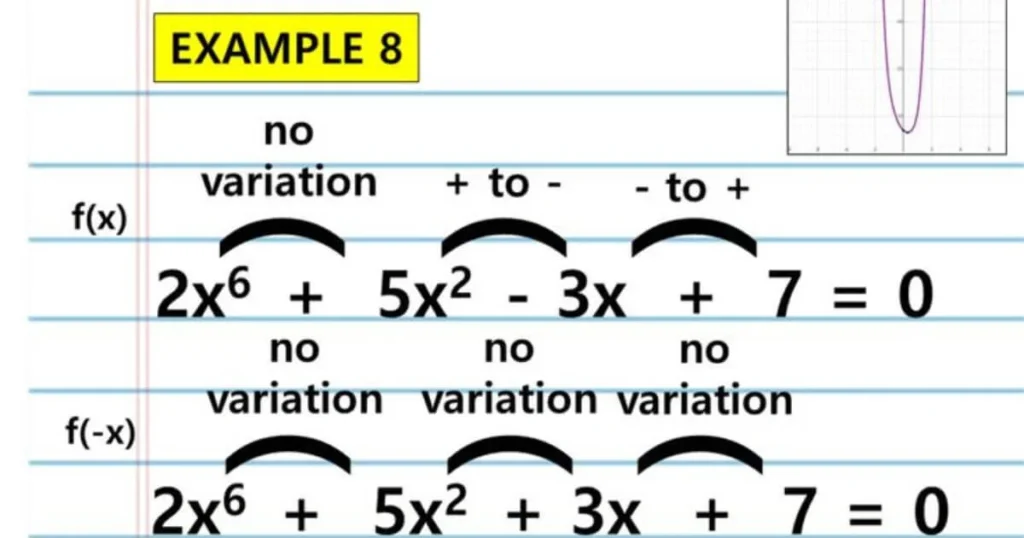
Descartes Rule of Signs:
Understanding the true roots of polynomial equations has been made possible by the mathematical technique known as Descartes Rule of Signs. This approach, which bears the name of the French mathematician and philosopher René Descartes, offers a methodical way to count the number of positive and negative roots in a polynomial equation. We will examine the importance, uses, and fundamental ideas of Descartes Rule of Signs in this extensive guide, which will clarify how it aids in navigating the challenging realm of polynomial equations.
Understanding Descartes Rule of Signs
Fundamentally, Descartes Rule of Signs is a technique for figuring out how many real roots—positive and negative—a polynomial equation has. Essentially, it helps scientists and mathematicians understand the nature of these roots without actually solving the equation.
The Rule in a Nutshell:
Two important details are provided by Descartes Rule of Signs:
The number of positive real roots:
The upper bound on the number of positive real roots is provided by the rule. For example, if the rule states that the number of positive real roots that can exist is limited to two, it could be zero, one, or two.
The number of negative real roots:
In a similar vein, the rule establishes a maximum quantity of negative real roots.
In a variety of disciplines, including science, engineering, and economics, where polynomial equations frequently depict real-world processes, this knowledge can be quite helpful.
Applying Descartes’ Rule of Signs:
There are two primary processes involved in applying Descartes Rule of Signs:
Counting Sign Changes:
The polynomial’s coefficients should first be arranged in decreasing degree order. Next, as you proceed from left to right, count how many times the signs change. The upper bound for the positive real roots of this sequence is given by the number of sign changes in it.
For instance, there are three sign shifts in the polynomial 3x^5 – 4x^3 + 2x^2 – x + 1, suggesting that it can have a maximum of three positive real roots.
Counting Positive Real Roots:
To find the true number of positive real roots, replace x with -x and carry out the sign-change counting once more. The upper bound for the negative real roots is provided by the number of sign changes in this sequence.
In the example, the sequence -3x^5 – 4x^3 – 2x^2 + x + 1 has no sign changes when -x is substituted for x in the polynomial. It can therefore have zero negative real roots at most.
Limitations and Exceptions:
It is vital to remember that Descartes Rule of Signs does not offer the precise number of real roots; rather, it gives an upper constraint. Moreover, this criterion only pertains to genuine roots; it gives no information regarding complicated roots. It also doesn’t take into consideration the potential for several roots. Contrary to what the rule implies, some polynomials might have less real roots.
The Underlying Principles:
Polynomial equation features serve as the foundation for Descartes Rule of Signs. Any roots shared by polynomial terms with alternating signs when they are multiplied together must likewise have alternating signs. The rule takes advantage of this fact to calculate the number of roots with distinct signs by looking at the sign changes in the polynomial’s coefficients.
Historical Significance:
René Descartes was a French philosopher, mathematician, and physicist who lived in the 17th century. He is the name of Descartes Rule of Signs. This rule is one of his mathematical legacies, and he made substantial contributions to several subjects. It is still a useful tool in algebra and calculus that has withstood the test of time, especially when estimating the number of real roots of polynomial equations.
Real-World Applications:
Many different fields can benefit from the use of Descartes Rule of Signs:
Economics:
Polynomial models are a common tool used by economists to analyze economic activity. Economists can estimate the number of positive and negative solutions in economic models with the use of Descartes Rule of Signs.
Engineering:
Polynomial equations are used by engineers in many different contexts, such as electrical circuit analysis and control system design. The rule aids in comprehending how systems behave.
Chemistry:
Polynomial equations can be used to describe chemical reactions. Chemists can forecast the number of probable reactions under specific conditions with the aid of this rule.
Physics:
Polynomial equations are used in physics in a variety of circumstances, such as wave equations and celestial body motion. The rule helps physicists understand the true nature of the roots of these equations.
Descartes Rule of Signs Calculator
By examining the signs of a polynomial equation’s coefficients, the Descartes Rule of Signs Calculator can be used to calculate the number of positive and negative roots that a polynomial equation may have. It facilitates the understanding of the polynomial’s root distribution without the need for manual computations by streamlining the use of René Descartes rule.
Conclusion:
In the field of polynomial equations, Descartes Rule of Signs is a key idea. It is an effective tool in mathematics and the sciences since it provides insightful information about the possible number of positive and negative real roots. This rule, while not perfect, has been useful in approximating the behavior of real-world systems represented by polynomial equations for mathematicians, scientists, and researchers. It continues to be evidence of René Descartes’s lasting contributions and the continuing significance of his mathematical legacy.
FAQS
By looking at the signs of a polynomial function’s coefficients, one can apply Descartes Rule of Signs, a mathematical formula, to estimate how many positive and negative real roots, or zeroes, there may be in the function.
A polynomial may include exactly three real zeros, but the precise number of real zeros varies depending on the elements that make up the polynomial.
Applying Descartes Rule of Signs, which examines sign changes in the coefficients, will yield the number of positive real zeros.
Mathematics does not have a particular “discard rule”; instead, it may refer to “Descartes Rule of Signs.”
